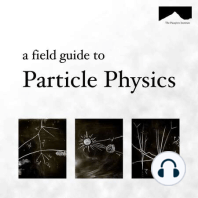8 min listen

Cosmic Rays : Part 1 : Particles from Space
Cosmic Rays : Part 1 : Particles from Space
ratings:
Length:
10 minutes
Released:
Mar 18, 2022
Format:
Podcast episode
Description
The Field Guide to Particle Physics https://pasayten.org/the-field-guide-to-particle-physics©2021 The Pasayten Institute cc by-sa-4.0The definitive resource for all data in particle physics is the Particle Data Group: https://pdg.lbl.gov.The Pasayten Institute is on a mission to build and share physics knowledge, without barriers! Get in touch.The Particle Data Group's write up on cosmic rays. See Figure 29.8 for a representation of the "ankle" feature in the spectrum.https://pdg.lbl.gov/2019/reviews/rpp2019-rev-cosmic-rays.pdfAnother representation of the power laws can be found in Professor Peter Gorham's Coursework on Ultra High Energy Cosmic Rays: http://www2.hawaii.edu/~gorham/UHECR.htmlCosmic RaysPart 1 - Particles from SpaceWell before the gigantic particle accelerators like the Large Hadron Collider at CERN or the Tevatron at Fermilab, particle physics was studied with balloons.Well. It still is. I don’t want to give an overly simplified take on the history of particle physics - but it’s fair to say that physicists will study high energy particles WHEREVER they can find them. And it just so happens that a large number of really high energy particles are constantly bombarding us from space.In our prior series on the ALPHA PARTICLE, we learned about the solar wind and how the Earth’s magnetic field catches much of that ionizing radiation, which we occasionally see displayed as the Aurora.Well. That magnetic field is no match for these cosmic rays, which come flying at us from deeper in space with much higher velocities than anything in the solar wind. These particles smash right though the magnetosphere and into the molecules of the upper atmosphere.From our perspective on Earth, these cosmic rays appear as showers of debris left over from those high altitude collisions. But they’re happening all the time.There’s so much debris out there that hundreds of particles - particles of that debris - have passed through you since you first hit play on this episode.### Cosmic RaysOn the 15th of October, 1991, a particle with enormous energy entered our upper atmosphere.A particle with this much energy had never been seen before on Earth. At least by humans. It had tens of millions of times more energy than anything produced at the Large Hadron Collider or FermiLab. All told. It had the kinetic energy of a baseball moving at around 60 miles per hour. All Packed. Into. A single. Particle. And it was heading right for us.The first thing it found upon arrival at Earth was the magnetic field. Traveling at such a high speed, it barely noticed the deflecting force and smashed through through into the atmosphere.Even in the rarified air of our upper atmosphere, tens of kilometers above the Earth’s surface, there are plenty of molecules to go around. Way more than you’d find in outer space. And what do particles from space with a lot of energy do when suddenly surrounded by a bunch of molecules? They spend it.That poor first molecule it encountered didn’t stand a chance. Whether it simply lost an electron or got completely blown apart is hard to say, but that incident cosmic ray quickly broke apart into a shower of particles high above the Earth. Pions were certainly created, but with that much energy - 50ish Joules of energy - all kinds of particles - from Lambda Zero to Kaons to the Cascades and Sigma baryons - could have been present. And all of them decayed as they usually do.The resulting shower of decays grew wider and wider, until the final, resultant charged pions decayed into muons. And the neutral pions decayed into photons. And any high energy photons decayed into electron-positron pairs who would in turn radiate the rest of the energy away.That final blast of radiation filled a circle kilometers wide that slammed into the US Army’s Dugway Proving ground in Utah desert and - as luck would have it - right into the detectors of a physics experiment.The detectors measured resultant spray and were able to back-calculate the energy
Released:
Mar 18, 2022
Format:
Podcast episode
Titles in the series (49)
The Guide to the Field Guide to Particle Physics: The guide starts with a host of different particle species. We’ll talk about their masses, charges and interactions with other particles. We’ll talk about how they are created, how they decay, and what other particles they might be made of. Before we begi by The Field Guide to Particle Physics